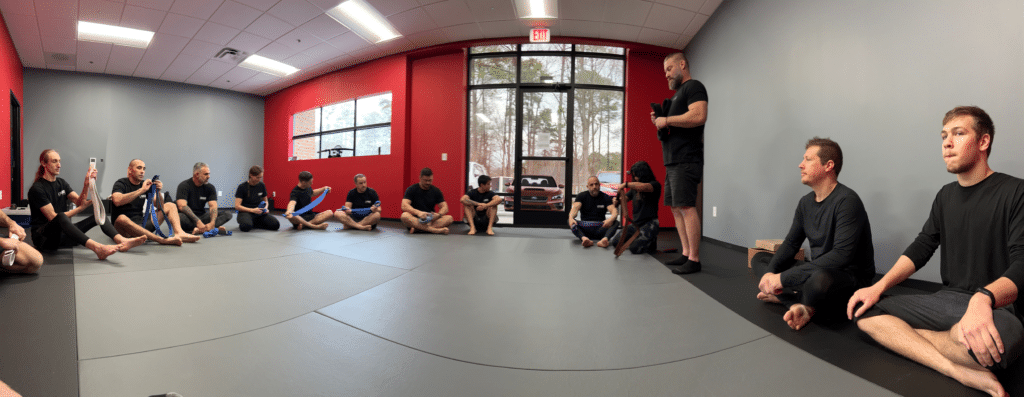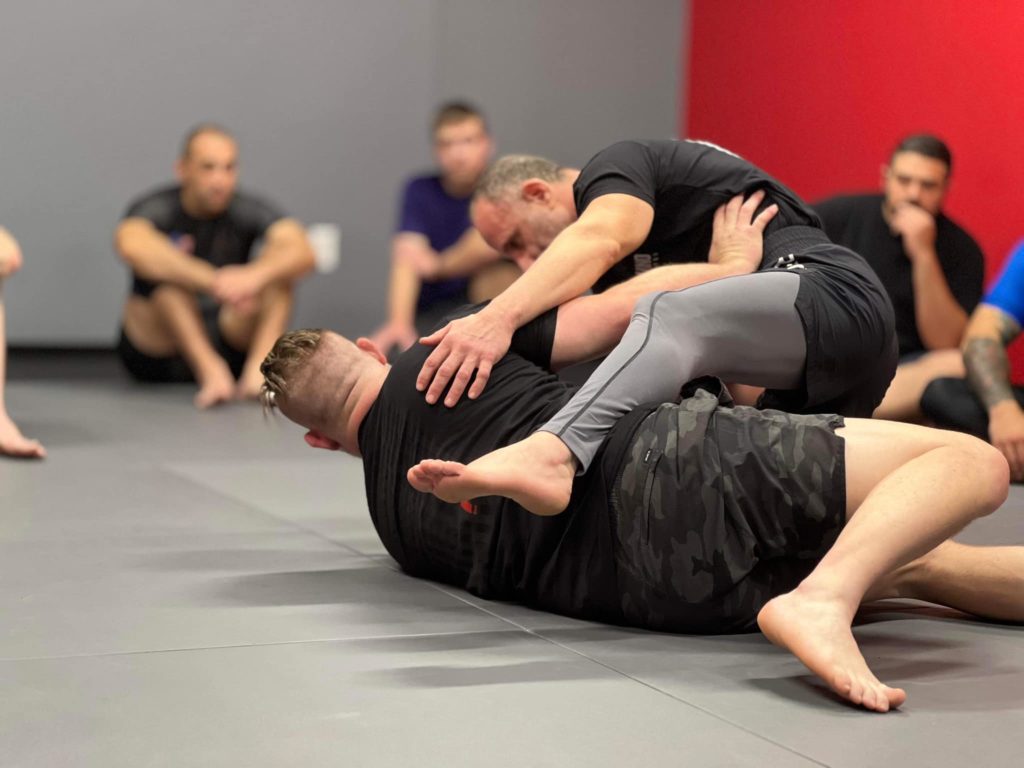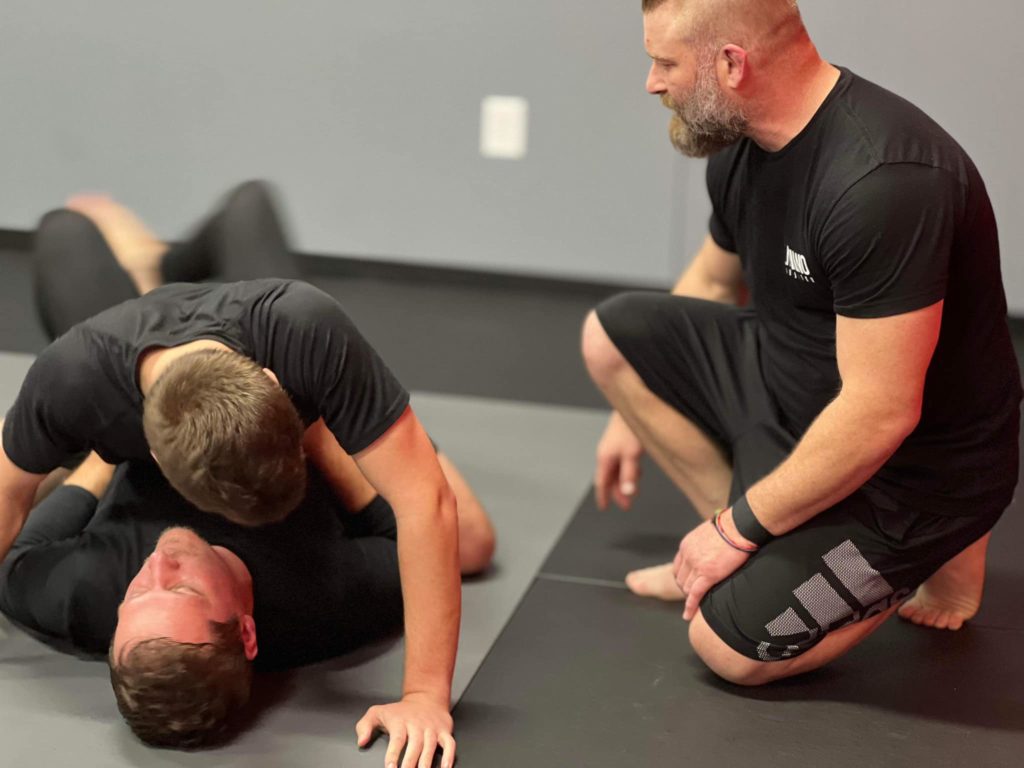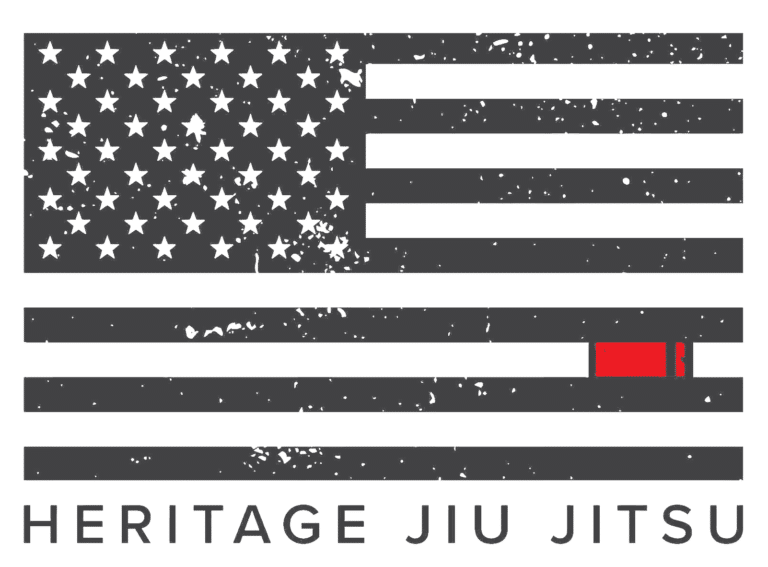Jiu Jitsu for Adults: Learn the Art of Self-Defense and Fitness
Few activities combine athleticism and mental fortitude as uniquely as Jiu Jitsu. This type of martial art seamlessly weaves together the benefits of physical activity, improved dexterity, and learning to be at peace in a controlled environment. As an adult, learning the basics of Jiu Jitsu can help you move more confidently through life.
From the moment you first step onto the mat, you become more aware of your surroundings, your body’s movements, and the way your opponent is positioning themselves. The strategic elements of Jiu Jitsu require a sharp mind, balanced with a powerful body. This type of self-defense helps you develop a few layers of resilience as you tackle physical challenges, as well as techniques and strategies used in the art.
Let’s start learning about the magnificent art of Jiu Jitsu! Together, we’ll explore the many benefits of learning this form of martial art and physical fitness discipline. Whether you’re just starting on your Jiu Jitsu journey or you’re a pro, there’s something for everyone. So, what are we waiting for? Let’s get started!

Quick Answer
You can find local Jiu Jitsu classes for adults by searching online, asking at martial arts studios in your area, or checking with community recreation centers. It is important to research each school thoroughly before committing to a program.
Introduction to Jiu Jitsu for Adults
Jiu Jitsu has become increasingly popular as a martial art for adults. Jiu Jitsu offers self-defense techniques, physical fitness benefits, and sporting aspects in its variety of practices. Originally developed in Japan, then modified in Brazil, and globalized since it’s arrival 30 years ago in the United States, Jiu Jitsu now practiced around the world and is becoming a popular way for adults to condition themselves. When looking at Jiu Jitsu for Adults, it can be different from other forms of martial art due to its emphasis on practical application and physical conditioning.
Before getting into the history of Jiu Jitsu, it is important to cover why one might be interested in taking up Jiu Jitsu as an adult. For some individuals simply knowing how to defend oneself can be enough motivation whilst others may have an interest in pursuing physical fitness more intensively. For those that take up Jiu Jitsu for fitness, there is an added bonus of knowing self-defense principles at the same time. Additionally, regular practice with the same group of people provides an opportunity to build strong friendships with other practitioners who can help motivate each other and create positive energy while learning and working out together.
As previously mentioned, there are pros and cons to practicing Jiu Jitsu as an adult. Those debating whether or not this particular martial art is ideal for them will need to weigh the factors carefully before making a decision either way. With that being said, it cannot be ignored how beneficial Jiu Jitsu can be when applied correctly: increased mental alertness, strength and endurance, and most importantly knowledge of defense that could prove invaluable when needed.
Now that we have discussed the basics of what distinguishes Jiu Jitsu for Adults from other forms and why someone might consider learning it as an adult, let us take a look at its rich historical roots which are integral to appreciating how far this martial art has come since its origination centuries ago.

History of the Martial Art
The history of jiu jitsu extends back to the feudal period in Japan and dates back to at least the mid-1800s. During this time, it was closely tied to one specific samurai clan: the Mitose family. The Mitose family had an extensive martial arts system that blended traditional Japanese budo with influence from Chinese martial traditions that blended together to become what we now refer to as jiu jitsu.
As jiu jitsu began to spread across Japan, it developed a reputation for being a highly effective art of self-defense and physical fitness. Soon, a number of variations began to emerge from different schools, instructing various types of submission holds and throws as well as more modern training techniques.
Today, jiu jitsu is a popular martial art around the world. It has been adapted for civilian defense purposes, as well as for tournament sport fighting and professional Mixed Martial Arts competitions. There is much debate within the martial arts community as to whether or not jiu jitsu can truly be considered an effective self defense system, with arguments both for and against its use in this context. Proponents claim it offers unparalleled levels of control and precision due to its focus on grappling techniques while detractors argue that relying solely on grappling is not enough when faced with multiple opponents or weapons-bearing adversaries.
Regardless of your stance on this debate, there is no denying that learning jiu jitsu can provide individuals with physical conditioning and self-defense skills, giving them an edge if ever faced with a dangerous situation. Furthermore, for those looking for a superior method of physical fitness and strength development, there can be many advantages gained through practicing jiu jitsu. As such, it is an excellent choice for adults seeking to learn a powerful martial art form. With the perfect combination of practicality, technique and tradition at its core, learning jiu jitsu may just be the best way to achieve increased fitness levels while also learning how to defend yourself against potential attackers in a safe manner. Now that you’ve learned about its history and relevance today, let’s take a closer look at some of the benefits associated with practicing this ancient martial art.
Benefits of Practicing Jiu Jitsu
Jiu Jitsu has long been a popular martial art form, used for self-defense both on and off the mat. Beyond its effectiveness in real life situations, however, it also provides a wealth of benefits for practitioners of all ages and abilities. From improved fitness to bolstered confidence, there are many advantages to gaining a mastery of jiu jitsu.
For starters, regular participation in jiu jitsu can result in greater overall physical health. Many practitioners observe significant increases not only in their strength, but also in their flexibility, coordination, agility, and balance. These improvements can be attributed to jiu jitsu techniques that utilize various body part combinations while engaging muscles throughout the entire range of motion. As such, one stands to gain more than just a strengthened core and improved posture; jiu jitsu may offer a lasting improvement in your overall physical condition.
Beyond its physical benefits, engaging regularly in jiu jitsu can help boost one’s self-esteem and mental state as well. Through training at various levels and against opponents of various skill sets, practitioners develop greater discipline while also engendering a sense of accomplishment through succeeding at subtler technical maneuvers. Character development is another area where the art can come into play; respect for others due to the nature of grappling combined with setbacks that arise from training failures may help build the kind of character traits sought after for individuals in all walks of life.
Clearly, there are plenty of advantages worth exploring when considering entering into the dynamic world of martial arts. Training regularly in jiu jitsu will give you not just an invaluable skillset for self-defense against assailants or attackers, but also quite possibly a greater sense of self-awareness and discipline going forward into future endeavors. Now that we’ve discussed its long legacy and delved into its wide array of benefits, let’s move on to focusing on how those wanting to start their own journey into the world of Jiu Jitsu can do so.

Beginning Your Jiu Jitsu Journey
Beginning your jiu jitsu journey is a big step, and it should not be taken lightly. Before starting on your jiu jitsu path, it’s important to consider all the information you have gathered about the martial art and ask yourself if this is something that truly inspires and excites you. While there are numerous benefits to learning jiu jitsu – such as increased fitness, self-defense skills, and camaraderie with other practitioners – the commitment and dedication needed to become proficient in the art should not be underestimated.
The notion of “suffering through” a challenging practice to reap its benefits is often discussed in the world of jiu jitsu. According to some experts, over time, students will experience a shift from feeling daunted by sparring sessions to enjoying them and testing their limits in each practice. This potential for growth comes with dedication and consistency, as these qualities guarantee steady improvement down the line. That being said, those who choose to pursue jiu jitsu should do so with full knowledge of what is expected of them. If a student chooses only to dip their toes in the pool of jiu jitsu and never fully commit to the practice, they may not experience the desired benefits or reach proficiency within the art.
Whether you choose to embark on a full-blown journey into jiu jitsu or remain at beginner level, diving into this art form can be a transformative experience full of physical and psychological rewards. As your progress moves forward, it’s important to get comfortable with the basics before pushing too hard and having difficulty keeping up with class curriculum. At that point, it’s time to decide whether continuing under one’s own steam or joining an academy for formal instruction would help maximize growth in terms of technique, strategy, and physical conditioning.
Choosing an Academy and White Belt Training
Now that you have decided to start your jiu jitsu journey and are ready for the next step of choosing an academy, it is important to consider the type of atmosphere and training principles each has. It is also important to think about whether a gi or no-gi class fit your interests and needs. While some academies may focus more on sport jiu jitsu, which focuses on competition and drilling for points, others might focus more on self defense. In addition to considering the type of training style the academy has, it’s essential to see if there are any pre-requisites such as experience in other martial arts.
When beginning white belt training, it’s important to remember that everyone starts off with a blank slate and will progress at their own pace. It’s also essential to realize that most techniques held at higher levels can come from even very basic techniques. Being open minded and embracing mistakes will allow practitioners to learn quickly and advance healthily. Allowing yourself time to take breaks between training sessions will also help maintain good energy during hard drills.
While learning these foundational principles of jiu jitsu can be daunting, proper practice and guidance can help lead practitioners towards success. Once these basics are understood, practitioners can build confidence and develop their skills further by grasping discipline within the art form.
Crucial Summary Points
It is important to consider the type of atmosphere and training principles of a jiu jitsu academy before starting up, whether it is focus on sport or self defense. Pre-requisites such as experience in other martial arts also need to be considered. When beginning white belt training, understand that everyone starts off with a blank slate and progress at their own pace. Open mindedness and allowing time for breaks between training sessions will help practitioners learn quickly and advance healthily. Proper practice and guidance can help lead practitioners towards success once these basics are understood.
Building Confidence and Discipline
After making the decision to choose a jiu jitsu academy and going through the initial white belt training sessions, individuals will likely gain a newfound sense of confidence and discipline. Those who have long struggled with anxiety or go to classes feeling intimidated by the instructors or fellow students will find their self-confidence slowly begin to rise. As their technique improves, individuals will feel more comfortable both on and off the mat.
Moreover, mastering jiu jitsu requires strict discipline for memorization and proper execution of techniques, positioning and reflexive movements. Keeping up with an ongoing and ever-evolving training schedule even outside class helps cultivate analytical skills, better decision making, and general physical fitness. With an encouraging environment, some may even start to view themselves as athletes as they build up a persistently positive routine.
The confidence and discipline cultivated during this stage will serve as the cornerstone for any future practice in jiu jitsu – but that is not where the benefits end. Learning to act after developing strong mental fortitude serves greatly when it comes to managing stress levels, potentially improving mental health. In the next section we’ll dive further into how this time-tested martial art can help improve mental well being.
- A 2019 study found that regular jiu-jitsu practice can reduce blood pressure and cortisol levels among adults.
- According to a 2018 case study, one month of Brazilian jiu-jitsu training significantly improved overall psychological state in adults with anxiety disorder.
- Research conducted in 2017 found that adult jiu-jitsu practitioners have lower body fat percentage than similar adult athletes who don’t practice it.
Mental Health Benefits of Practicing Jiu Jitsu
It is understood that strength and physical fitness are not the only elements of self-defense. Practicing jiu jitsu also can bring many mental health benefits to those who dedicate themselves to learning the art. First and foremost, studying jiu jitsu provides a sense of empowerment. By stepping onto the mat, students of the martial art become part of an ancient legacy with its own culture and holistic approach to life. Learning techniques and training your body will help build confidence coming off of the mat as well. Students learn to protect themselves in real-world situations with techniques they have practiced and honed honing at class.
Furthermore, by committing to regular practice sessions, practitioners of jiu jitsu might find themselves better able to cope with anxiety and depression. The physical activity itself has a calming effect on the practitioner’s body and mind, allowing for a momentary reprieve from stressors outside the dojo. Additionally, having a group of fellow martial artists in which to interact builds comradery and camaraderie, providing support whenever needed. In such a safe space, practitioners are free to push their boundaries by testing their limits and challenging themselves in mental and physical ways.
As further evidence of this relationship between jiu jitsu and mental wellness, there is mounting research showing that martial arts like Jiu Jitsu are effective in treating post-traumatic stress disorder (PTSD). In addition to building resilience against future trauma exposure, studies also suggest that martial arts can be used as an integral part of recovery from past traumas.
Therefore it is clear that practicing Jiu Jitsu can greatly benefit one’s mental wellbeing. It builds confidence, discipline, calms anxieties, fosters comradery among peers, and even helps treat PTSD symptoms over time. All these benefits come together through consistent practice, forging brave warriors both on and off the mat. Now that we have discussed some of the mental health benefits available to adult practitioners of Jiu Jitsu, let us now move onto discuss how tournaments provide a platform for practitioners to showcase their hard earned skills . . .
Types of Jiu Jitsu Tournaments
Jiu Jitsu tournaments are a great way for practitioners to test their skills and experience competition outside of their dojo. As many Jiu Jitsu practitioners can attest, training with other players of different sizes and skill levels can help elevate one’s own game. That being said, there are several types of tournaments to choose from and it’s important for players to be informed about the differences between them.
The most common form of Jiu Jitsu tournament is the championships which are typically divided into weight classes. In this type of tournament, points are given based on techniques executed throughout each match. Matches end when either opponent submits or when the time limit entry expires. This type of tournament is ideal for those that have plenty of technical expertise in the sport as well as an understanding of its positioning dynamics.
Another popular tournament format is submission only tournaments, which typically have neither a time limit nor points system. This type of tournament makes for an exciting spectator sport since submissions are the only factor that decides who advances. Grappling tournaments tend to be less glamorous than the major championship events but offer a great opportunity for those looking to gain more experience competing in Jiu Jitsu. For these competitions, participants may be split into categories by belt rank or weight classes; prospective grapplers can expect two rounds of consistent matches with breaks in between.
Finally, there are hybrid tournaments which combine elements from both submission only and championships events. Hybrid tournaments differ from traditional ones in that they allow participants to score points while still allowing submissive submissions to decide who advances. Some believe that hybrid tournaments provide an accompanying balance of skill and strategy; however, others argue that it’s difficult to implement both rulesets in a single unified set-up without causing any confusion among participants or referees alike.
Answers to Frequently Asked Questions with Detailed Explanations
Are there any special considerations for adults when learning jiu jitsu?
Yes, there are a few special considerations for adults learning jiu jitsu. As an adult learner, you must be mindful of your age and physical condition. Your body may no longer be able to perform the same feats that you could when you were younger, so it is important to adjust your training to accommodate any changes in your strength or flexibility. You should also focus on training smart by avoiding unnecessary injuries. It can also helpful to set realistic goals and objectives in order to avoid getting discouraged early on in your training process. Lastly, as someone with more life experience, you may have more investment in learning the art of jiu jitsu as a way of self-defense and fitness compared with younger learners. This enthusiasm can often lead to diligent practice and steady progress.
What kinds of fitness benefits can an adult expect from practicing jiu jitsu?
Jiu jitsu is an incredibly effective form of martial art that offers a wide range of fitness benefits for adults. By practicing this unique martial art, adults can expect to gain improvements in overall strength and endurance due to the highly physical nature of the training. Practicing jiu jitsu will challenge every muscle group and help improve balance, coordination, and agility. Additionally, cardiovascular fitness will be improved as each class requires regular bursts of energy throughout the session. Regular practice can increase flexibility and improve body awareness, which will provide both physical and mental benefits. Jiu jitsu also provides excellent stress relief as it involves intense physical activity while also giving practitioners time to clear their minds and focus on their technique. Ultimately, the combination of physical and mental gains from this unique martial art make it an invaluable tool for any adult’s wellness journey.
What are the specific techniques used in jiu jitsu?
Jiu jitsu is an art form that combines judo, Brazilian jujutsu, and Japanese jujutsu to create a practical self-defense system. Specific techniques used are traditional throws, joint locks and chokes, sweeps and take downs, striking attacks, reversals and submission holds.
Throws, or nage wazi in Japanese, involve off balancing the opponent and controlling their movement for a takedown. Joint locks and chokes are when you apply pressure to a joint or throat to control an attacker or break their posture. Sweeps can send an opponent to the floor to gain superior ground control while take downs take them down against their will. Striking attacks can be effective but there is more control with grabs and throws. Reversals are when you shift your position to counter your opponent’s movements. Finally, submission holds use leverage to force an attacker into submission with pain compliance or limb manipulation.
In summary, jiu jitsu offers many possibilities for defending oneself in a safe and ethical manner. With practice, it can become instinctive and in some cases even be a learning experience for both practitioners.

